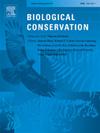Evaluating the effectiveness of protected areas and community-managed lands in capturing multiple dimensions of frugivorous biodiversity in the Tropical Andes
IF 4.9
1区 环境科学与生态学
Q1 BIODIVERSITY CONSERVATION
引用次数: 0
Abstract
The Tropical Andes, known for its rich biodiversity, faces threats like habitat loss and climate change, making conservation in these areas crucial. Traditional conservation efforts often focus on taxonomic diversity (TD), overlooking functional diversity (FD), which is vital for ecosystem health. Understanding the role of community-managed lands in biodiversity protection is also essential for achieving conservation goals. This study used the Frugivoria trait database to assess FD of frugivorous birds and mammals in the Tropical Andes, species critical for seed dispersal and forest health. We analyzed the spatial alignment and mismatch between TD and FD in high diversity areas and evaluated the spatial distribution of Functionally Unique, Specialized, and Endangered (FUSE) species, which have irreplaceable functional roles. Our findings reveal spatial discrepancies between FD and TD, highlighting the limitations of relying solely on TD for conservation. Additionally, we examined biodiversity levels in strict and less strict protected areas (PAs), finding that strict PAs do not always contain higher biodiversity levels than less strict ones. Some strict PAs better represent FUSE species distributions, but many areas with more FUSE species and higher TD remain unprotected. Notably, community-managed lands exhibited higher FD than other PAs in the same IUCN PA category, underscoring the importance of Indigenous Lands and community-managed areas in protecting FD. As global conservation aims to protect 30 % of Earth's land by 2030, our findings emphasize the need to incorporate multiple biodiversity dimensions and utilize other effective area-based conservation measures (OECMs) for effective and sustainable conservation in the Tropical Andes.
求助全文
约1分钟内获得全文
求助全文
来源期刊

Biological Conservation
环境科学-环境科学
CiteScore
10.20
自引率
3.40%
发文量
295
审稿时长
61 days
期刊介绍:
Biological Conservation is an international leading journal in the discipline of conservation biology. The journal publishes articles spanning a diverse range of fields that contribute to the biological, sociological, and economic dimensions of conservation and natural resource management. The primary aim of Biological Conservation is the publication of high-quality papers that advance the science and practice of conservation, or which demonstrate the application of conservation principles for natural resource management and policy. Therefore it will be of interest to a broad international readership.
 求助内容:
求助内容: 应助结果提醒方式:
应助结果提醒方式:


